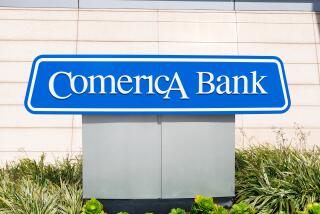Bank Board Says S&L; Industry’s Losses Fell Significantly in 3rd Quarter
WASHINGTON — Savings and loan industry losses eased substantially during the third quarter, falling 60% as the government accelerated its program of merging or closing crippled institutions, the Federal Home Loan Bank Board said Tuesday.
The shrinking losses provided a modestly encouraging note in the persistent S&L; crisis, which experts fear could lead to a multibillion-dollar bailout by taxpayers. Any reduction in the flow of red ink from the crippled segment of the industry will cut the eventual size of any financial rescue operation financed from federal revenues.
A preliminary report showed that the industry’s total losses were $1.52 billion during the July-September period, compared to $3.82 billion in the second quarter. The anticipated loss of $1.52 billion is less than the $2-billion deficit previously predicted by the bank board. “It shows our program is working: The medicine is taking effect,” bank board spokesman Karl Hoyle said.
The agency has arranged the merger or shutdown of more than 140 insolvent S&Ls; so far in 1988 and hopes to raise the total to 200 by year-end.
The combinations and mergers help reduce costs by cutting the work force and by closing unnecessary branches. In some of the more prominent cases, the bank board has also arranged for outside investors to put cash into the troubled institutions in return for guarantees against future losses on the troubled real estate portfolios.
The S&L; industry, which consists of 3,028 federally insured institutions, had operating profits of $364 million during the third quarter, the bank board said in reporting the preliminary quarterly results. This compared to $224 million in the second quarter.
The size of the operating income--the money earned from ordinary business activities--reflects the fact that most institutions are profitable. However, the S&Ls; in financial trouble have losses so big that they overwhelm the earnings of the rest of the industry. The non-operating losses totaled $1.3 billion during the third quarter. This reflects the massive writedowns that occur when S&Ls; recognize the shrinking value of their investments in real estate.
The Southwest has been particularly hard hit. Homes, apartments and shopping center developments have been financially battered by the deep recession in Texas, with the investments worth substantially less than their value when the loans were originally made. Essentially, these are loans that have gone sour, with little hope of recovery anytime soon.
Although substantial, these writedowns in the third quarter were an improvement from the massive non-operating loss of $3.5 billion in the prior quarter.
Bank board officials hope the latest figures signal that the industry has suffered through the worst period of writeoffs and is entering a period of relative stability.
They remain optimistic and are hopeful that the S&L; problem can be managed. One plan under discussion at the bank board calls for the sale of bonds to raise additional funds for the federal insurance fund. The U.S. Treasury would pay the interest on the bonds.
The bank board has authority from Congress to sell $10.8 billion in bonds. Any new issue would be substantially larger, because estimates of the total funds needed range above $50 billion.
The final version of the bank board’s proposal will be submitted to the Treasury next month. The Treasury will issue its recommendations next year, after President-elect George Bush takes office.
Meanwhile, the Treasury is reviewing the bank board’s reports and preparing a new estimate of money that eventually may be needed to dispose of the crippled S&Ls.;
More to Read
Inside the business of entertainment
The Wide Shot brings you news, analysis and insights on everything from streaming wars to production — and what it all means for the future.
You may occasionally receive promotional content from the Los Angeles Times.










